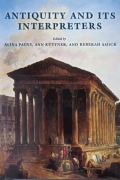 Rebekah Smick, Alina Payne, Anne Kuttner (eds.). Antiquity and Its Interpreters. Cambridge, UK; New York: Cambridge University Press, 2000.
Rebekah Smick, Alina Payne, Anne Kuttner (eds.). Antiquity and Its Interpreters. Cambridge, UK; New York: Cambridge University Press, 2000.Find it on: Amazon
Antiquity and its Interpreters examines how the physical and textual remains of the ancient Romans were viewed and received by writers, artists, architects, and cultural makers of early modern Italy. The importance of antiquity in the Renaissance has long been acknowledged, but this volume reconsiders the complex relationship between the two cultures in light of recent scholarship in the field and a new appreciation and awareness of the act of history writing itself. The case studies analyze specific texts, the archaeological projects that made 'antiquity' available, the revival of art history and theory, the appropriation of antiquities to serve social ideologies, and the reception of this cultural phenomenon in modern historiography, among other topics. Demonstrating that the antique model was itself an artful construct, Antiquity and its Interpreters shows that the originality of Renaissance culture owed as much to ignorance about antiquity as to an understanding of it. It also provides a synthesis of seminal work that recognizes the reciprocal relationship of the Renaissance to antiquity.




